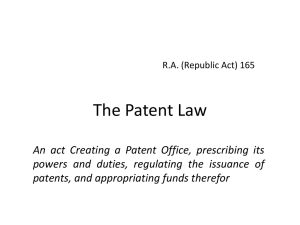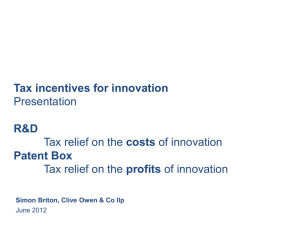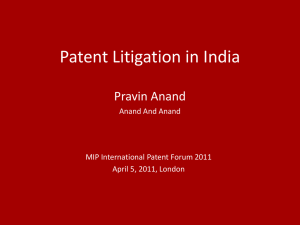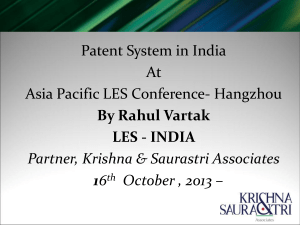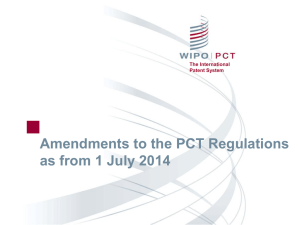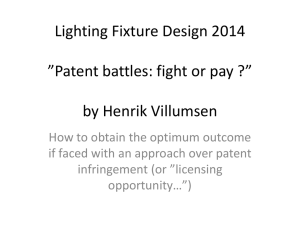Wind innovation in China - Center for Climate and Energy Decision
advertisement
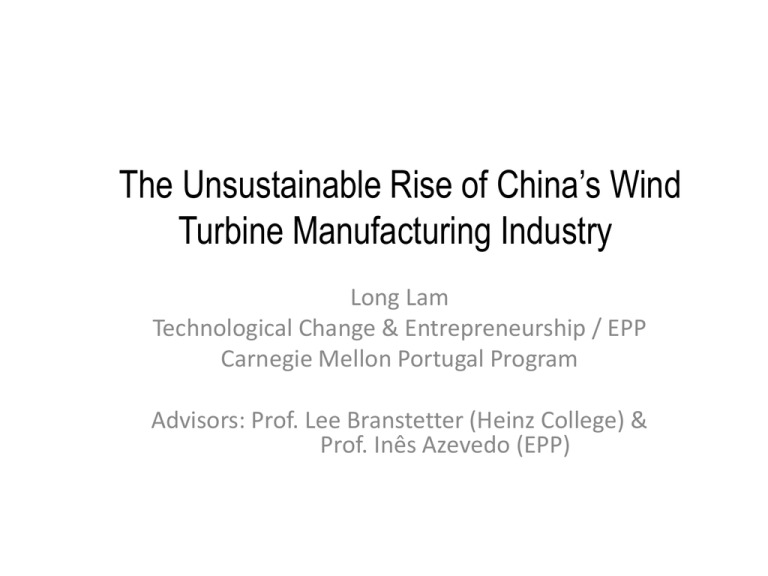
The Unsustainable Rise of China’s Wind Turbine Manufacturing Industry Long Lam Technological Change & Entrepreneurship / EPP Carnegie Mellon Portugal Program Advisors: Prof. Lee Branstetter (Heinz College) & Prof. Inês Azevedo (EPP) Key Messages • Production and innovation are thought to go hand in hand • China has emerged as a global player in the wind power industry with more wind capacity than another other country – China is poised to win the innovation race? (Thomas Friedman) • Patent count indicates few Chinese inventions • Patent citation analysis suggests that the wind power industry is relatively mature – Conditions for an industry to migrate to and flourish in China, especially with appropriate policies 2 CO2 emission per capita (tonne) 40 30 20 10 0 China is the world’s largest polluter 0 1M 2M 3M 4M 5M 6M 7M 8M Greenhouse gas emission (Thousands of tonnes CO2e) 3 World Bank, AFP/Getty Images China Installations China’s Wind Energy Status 20,000 80,000 18,000 16,000 US Installations 60,000 12000 50000 12,000 40000 8000 30000 6000 20000 4000 10000 2000 0 0 2000 2002 2004 2006 2008 2010 2012 Foreign Cumulative 10,000 40,000 8,000 30,000 6,000 20,000 4,000 10,000 2,000 0 0 2002 2003 2004 2005 2006 2007 2008 2009 2010 2011 2012 Annual (MW) 10000 50,000 Cumulative (MW) 14,000 Annual (MW) 60000 Cumulative (MW) 14000 Domestic 70,000 Domestic Foreign Cumulative 4 AWEA, Wind Energy Monthly, Shi (2004-2007) Breakdown of China’s annual wind turbine installation capacit 100% 90% 80% 70% 60% 50% 40% 30% 20% 10% 0% 2002 2003 2004 2005 Foreign 2006 2007 2008 2009 2010 2011 2012 Domestic and Joint Ventures 5 AWEA, Wind Energy Monthly, Shi (2004-2007) Sources of Growth • 1. Innovation fuels growth – Imitation mode cooperative innovation indigenous innovation (Ru et al, 2012) – Goldwind as an exemplary case study of innovation (Lewis, 2013) – Innovative but facing challenges & problems (Klagge et al., 2012) • 2. Cost and policies – Cost advantages to manufacture standardized products – Special support policies – The wind power industry is mature yet Chinese firms hold few patents 6 Patent as Innovation Measure – Effective to protect product innovation (Teece, 2000) – Related to the inputs of the innovative process (Jaffe & Trajtenberg, 2002) • Patent count is simplest and most straightforward – Assumes that all patents have equal value • Patent citation count – Number of times a patent is cited after it is published – Inventors have the incentives to not want to overclaim or underclaim – Truncation and obsolescence issues • Patent citation analysis 7 Measuring Innovation: Data • European Patent Office (EPO) is a regional patent office • Regional patent office • Maintains and publishes all-inclusive Worldwide Patent Statistical Database aka “PATSTAT” (1976 – October 2012) • PATSTAT • Data from over 100 countries • 60 million patent applications; 30 million granted patents, etc. • Many application details, including citation information • Sample identification: patent classification and abstract keyword search • Wind in “F03D” (Johnstone et al, 2009) • Abstract search (Nemet, 2009) in EN, DE, FR, & ES 8 Patent Count Results: PATSTAT • 13,279 wind patents worldwide – Most activities in U.S. and Europe, but China as well – Most recent peak began in 1990s Patent Offices 9 Patent Count Results: EPO – 985 EPO patents • Geographic location as proxy for nationality • German inventors have the most wind power patents (365), then Danish (156) and American (92); two from Chinese inventors • Uptick in patenting activities when Chinese firms displace foreign producers and pivot to other major markets 10 Inventor Nationality Sources of China’s innovation Branstetter et al (2013) 2005 Renewable Energy Law Renewable Energy Targets 10% RE by 2010, 15% RE by 2020 10GW wind by 2010, 30GW by 2020 Grid Companies Mandatory Grid Connect Mandatory Electricity Purchase Priority Dispatch & Grid Mgmt Project Developers Mandatory Market Share Req. Tenderbased Pricing Tiered FIT (2009) WTG Manufacturers 70% Local Content Req. R&D Support RE Customer Surcharge 12 NDRC Notice 1504 • Local content requirement – “The approval of wind farm construction shall be based on the wind energy development plan… The rate of using domestic equipment in the production of the wind farm must be above 70 percent.” • Manufacturers established bases in China – Gamesa: constructed local assembly plant, trained local companies • Revoked in 2009 – Foreign manufacturers already built in-country facilities – Worries of excess capacity in the supply chain 13 100000 180 90000 160 80000 140 70000 120 60000 100 50000 80 40000 60 30000 20000 40 10000 20 0 2005 2006 2007 China, CEC China, Elec 2008 2009 2010 China, CWEC US, Elec 2011 2012 US, AWEA 2013 0 Electricity Generated (TWh) Installed Capacity (MW) Industry Challenges Conclusions & Policy Implications • China is a strong player in the wind power industry, but innovation has little to do with this transition – Patent citation analysis shows that later patents are less likely to be cited than earlier patents, a sign of industry’s maturity – Yet China has very few patents • China is not the source for technological innovation opportunities in wind power • China was able to build an industry from scratch but not without great costs – Connection (only 80% grid-connected) & curtailment (~20%) issues – Consolidation: the majority of manufacturers has closed down 15 Acknowledgement • Fundação para a Ciência e a Tecnologia • Prof. Inês Azevedo • CMU|Portugal Program • Prof. Lee Branstetter • CMU Scott Energy Institute • Nico Doranov (www.datagnostics.net) • The Climate and Energy Decision Making • Matej Drev (Georgia Tech) Center (CEDM) • Namho Kwon (CMU) Carnegie Mellon Electricity Industry Center • Prof. Xue Lan (Tsinghua) (CEIC) • Guangwei Li (CMU) American Wind Energy Association • Prof. Sally Xu (Peking University) • Prof. Zhou Yuan (Tsinghua) • • 16 References • • • • • • • • • Cabellero, R. and Jaffe, A. (1993). “How High are the Giants’ Shoulders: An Empirical Assessment of Knowledge Spillovers and Creative Destruction in a Model of Economic Growth”, NBER Macroeconomics Annual, Vol. 8, pp.1574. Cockburn, Iain M., Hall, Bronwyn H. and Trajtenberg, Manuel, National Bureau of Economic Research Patent Database: Data Overview (November 2, 2007). 2007 Kauffman Symposium on Entrepreneurship and Innovation Data. Jaffe, A.B. and Trajtenberg, M. (2002). Patents, Citations and Innovations: A Window on the Knowledge Economy. Boston: MIT Press. Jaffe, A.B. and Trajtenberg, M. (1996). “Flows of Knowledge from Universities and Federal Labs: Modeling the Flow of Patent Citations over Time and Across Institutional and Geographic Boundaries.” NBER Working Paper No. 5712. Johnstone, N., Hascic, I., & Popp, D. (2009). “Renewable Energy Policies and Technological Innovation: Evidence Based on Patent Counts.” Environmental and Resource Economics, 45(1), 133–155. Klagge, B., Liu, Z, Silva, P. (2012).“Constructing China’s Wind Energy Innovation System.” Energy Policy, 50, p. 370382. Lewis, Joanna. (2013). Green Innovation in China: China's Wind Power Industry and the Global Transition to a LowCarbon Economy. New York: Columbia University Press. Print. Nemet, G. F (2009). Demand-pull, technology-push, and government-led incentives for nonincremental technical change. Research Policy, 38(5), 700–709. Ru, P, Zhi, Q., Zhang F., Zhong X., Li J., Sun, J. (2012), “Behind the development of technology: The transition of innovation modes in China’s wind turbine manufacturing industry.” Energy Policy, Volume 43, p. 58-69, ISSN 03014215, 10.1016/j.enpol.2011.12.025. 17
